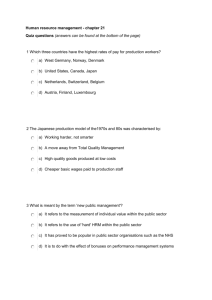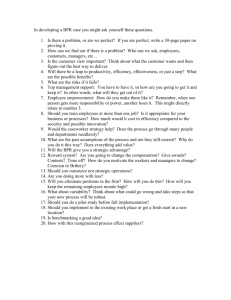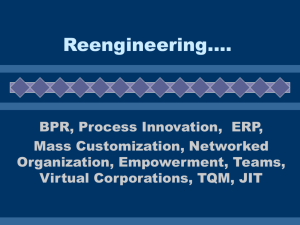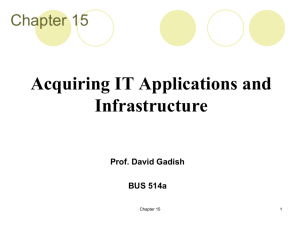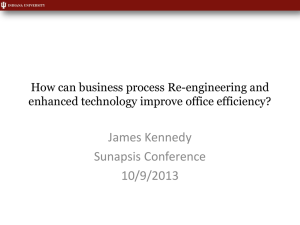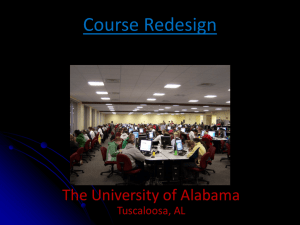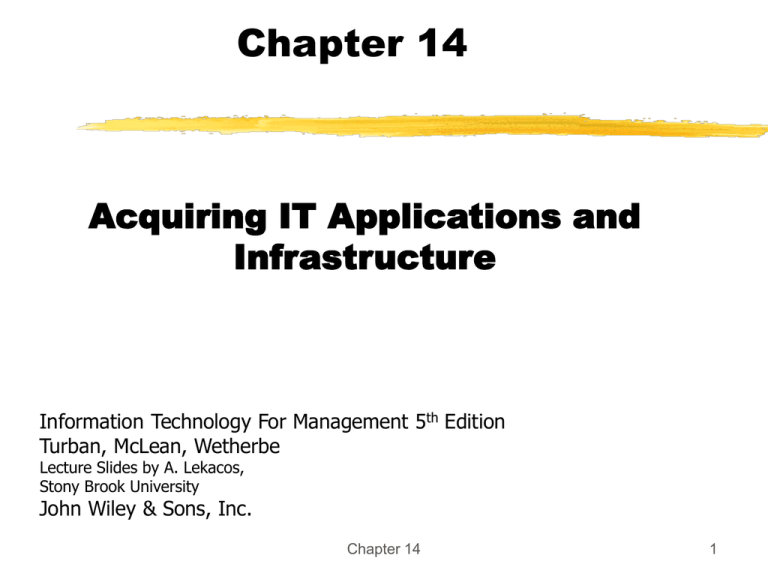
Chapter 14
Acquiring IT Applications and
Infrastructure
Information Technology For Management 5th Edition
Turban, McLean, Wetherbe
Lecture Slides by A. Lekacos,
Stony Brook University
John Wiley & Sons, Inc.
Chapter 14
1
LEARNING OBJECTIVES
•
•
•
•
•
•
•
•
Describe the process of IT acquisition or development.
Describe IT project identification, justification, and planning.
List the major IT acquisition options and the criteria for option selection.
Describe the use of criteria for selecting an acquisition approach.
Describe the role of ASPs.
Describe the process of vendor and software selection.
Understand some major implementation issues.
Understand the issue of connecting IT applications to databases, other
applications, networks, and business partners.
• Describe the need for business process redesign and the methodologies
for doing it.
• Explain the IT support for process redesign and BPR, and describe
redesign efforts, successes, and failures.
Chapter 14
2
Information System Acquisition
Various Approaches to obtaining Information Systems
• Buying
• Leasing
• Building
The Acquisition issue is still complex
Chapter 14
3
The five major steps of
Acquisition
Chapter 14
4
Acquiring IT Applications
Option 1 - Buy
Chapter 14
5
Acquiring IT Applications
Option 2- Lease
• TYPES OF LEASING VENDORS Leasing can be done in
one of two ways.
• The first way is to lease the application from an outsourcer
and install it on the company’s premises. The vendor can
help with the installation and frequently will offer to also
contract for the operation and maintenance of the system.
Many conventional applications are leased this way.
• The second way, using an application system provider
(ASP), is becoming more popular.
Chapter 14
6
Acquiring IT Applications
Option 2 - Lease- Utility Computing
Chapter 14
7
Acquiring IT Applications
Option 3 – Development In-House
• IN-HOUSE DEVELOPMENT APPROACHES. There are two major
approaches to in-house development: building from scratch or
building from components.
• Build from scratch. This option should be considered only for specialized
applications for which components are not available. It is an expensive and slow
process, but it will provide the best fit.
• Build from components. Companies with experienced IT staff can use standard
components (e.g., a secure Web server), some software languages (e.g., Java,
Visual Basic, or Perl), and third-party subroutines to create and maintain
applications on their own. (Or, companies can outsource the entire development
process to an integrator that assembles the components.) From a software
standpoint, using components offers the greatest flexibility and can be the least
expensive option in the long run. However, it can also result in a number of false
starts and wasted experimentations. For this reason, even those companies with
experienced staff are frequently better off modifying and customizing one of the
packaged solutions as part of the “buy” option.
Chapter 14
8
Systems Development Life Cycle
Provides a comprehensive formal framework for designing and developing
systems for the effective and efficient processing of information. There is
no universal, standardized version of the SDLC however a typical eight
stage model is shown below.
Note that the stages overlap: One stage
may start before the previous stage ends.
This is in contrast to the traditional
waterfall method, in which the work flows
through all the tasks in one stage before
going on to the next stage. Also note that
the processes can go backward more than
one stage.
SDLC:
Formal and disciplined approach to systems development
Chapter 14
9
SDLC - Stages
1. Stage 1: Project initiation. Projects often start when a
manager has a problem or sees an opportunity.
2. Stage 2: Systems Analysis And Feasibility Studies
consists of two phases of analysis: systems analysis
and feasibility studies.
•
Systems analysis is the phase that develops a thorough
understanding of the existing organization, its operation,
and the situation that is causing a problem. Systems
analysis methods include:
•
•
•
•
observation
review of documents
interviews
performance measurement.
Chapter 14
10
SDLC – Stages
•
Feasibility studies calculate the probability of success of the proposed
solution and include:
•
•
•
•
3.
Continued
Technology.
Economics.
Organizational factors
Legal, ethical, and other constraints.
Stage 3: Logical Analysis And Design emphasizes the design of system
from the user’s point of view. It identifies information requirements and
specifies operations such as input, output, processing and storage. To
represent logical processes and data relationships modeling tools such
as data flow diagrams and entity-relationship diagrams can be used. The
logical design is followed by a physical design.
Chapter 14
11
SDLC – Stages
Continued
4.
Stage 4: Development or Acquisition the actual development or
acquisition of the system.
• IS personnel use the specifications to purchase the hardware and
software required for the system.
• Programmers write code for parts of the system.
• Technical writers develop documentation and training materials.
• IS personnel test the system
• Users test prior to the actual implementation.
5.
Stage 5: Implementation is an important stage; the system can fail
here even if it has all the specified functionality.
• Users need training
• Forms need to be ordered
• Help desk needs to be created
Chapter 14
12
SDLC – Stages
5.
Stage 5: Implementation - continued
•
Also requires a conversion from a previous system. Conversion approaches
include:
•
•
•
•
6.
Continued
Parallel conversion: The old and new systems operate concurrently for a test
period, and then the old system is discontinued.
Direct cutover: The old system is turned off, and the new system is turned on.
Pilot conversion: The new system is implemented in a subset of locations (for
example, some of the branches in a large banking chain) and is extended to
remaining locations over time.
Phased conversion: Large systems often are built from distinct modules. If the
modules were originally designed to be relatively independent, it may be possible
to replace the modules one at a time.
Stage 6: Operation. Post production environment.
Chapter 14
13
SDLC – Stages
Continued
7.
Stage 7: Post-Audit Evaluation reviews the stages and processes to
determine best practice methods.
8.
Stage 8: Maintenance. Every system needs two regular types of
maintenance:
Fixing of bugs
Regular system updating
Therefore it is important that the design and development
stages produce systems that are easy to maintain and are
flexible enough to handle future expansion, upgrading and
capacity increases.
Chapter 14
14
Alternatives to SDLC
methodologies
The traditional SDLC approach works best on projects in which users have
a clear idea about their requirements. Projects that require major changes
in existing processes, through reengineering or development of new
processes or those that build upon inter-organizational and international
systems using Web technologies indicate a need for alternatives or
supplements to conventional SDLC methodologies.
•
Some alternatives:
•
•
•
•
•
•
Prototyping
Joint application design (JAD)
Rapid application development (RAD)
Object-oriented development (OO)
Extreme Programming (XP)
Component-based development
Chapter 14
15
Alternatives •
•
continued
Prototyping (evolutionary development): Instead of spending a lot
of time producing very detailed specifications, the developers find out
only generally what the users want. The developers do not develop
the complete system all at once. Instead they quickly create a
prototype, which either contains portions of the system of most
interest to the users, or is a small-scale working model of the entire
system. After reviewing the prototype with the users, the developers
refine and extend it. This process is continued until the final
specifications.
Joint application design (JAD) is a group-based method for
collecting user requirements and creating system designs. It is used
within the systems analysis and design stages of the SDLC. Unlike the
traditional SDLC, where the analysts interview individual users of the
new information system to understand their needs JAD has a meeting
in which all users meet simultaneously with analysts. During the
meeting, all users jointly define and agree upon systems
requirements.
Chapter 14
16
System Development
Alternatives
Many organizations are using approaches that shift the construction of
systems from their information systems department to others.
• End-User Development:
• Outsourcing:
process
Let users build their own systems
Outsource the entire systems development
• Purchasing:
(“The make-or-buy decision”) Let users use offthe-shelf software packages.
• Utility computing, consists of a virtualized pool of “self-
managing” IT resources (computing power and storage capacity)
that can be dynamically allocated for any application
Chapter 14
17
System Development
Alternatives
Outsourcing and Application Service Providers.
•
•
•
Outsourcing: use of outside contractors or external organizations
to acquire IT services.
ASP-Application Service Provider, is an agent or vendor who
assembles the software needed by enterprises and packages them
usually with outsourced development, operations, maintenance,
and other services.
The main difference between an ASP and an outsourcer is that an
ASP will manage application servers in a centrally controlled
location, rather than on a customer’s site.
Chapter 14
18
E-Business Application Development
The diversity of e-business models and applications, which vary in size
from a small store to a global exchange, requires a variety of development
methodologies and approaches.
•
There are several options for developing e-business (e-biz)
applications:
• Buying an existing package can be cost-effective and timesaving in
comparison to in-house application development.
• Leasing is advantageous over buying in those cases where
extensive maintenance is required, or where the cost of buying is
very high.
• Develop in-house.
•
•
•
Build from scratch.
Build from components.
Enterprise application integration
Chapter 14
19
System Development
Alternatives
Chapter 14
20
Advantages and
Disadvantages
Chapter 14
21
Software Vendor Selection
A Six Step Selection Method
1.
Identify Potential Vendors
2.
Determine the Evaluation Criteria
RFP-Request For Proposal
List of users
3.
Evaluate Vendors and Packages
4.
Choose the Vendor and Package
5.
Negotiate A Contract
6.
Establish A Service Level Agreement(SLA)
Chapter 14
22
Software Selection
Chapter 14
23
Connecting To Databases and
Business Partners
EC MUST BE INTEGRATED
1.
Many IT Applications need to be connected to a Database
2.
IT must be connected to business partners, especially for B2B ECommerce
Chapter 14
24
Business Process Redesign (BPR)
Environmental pressures from customers, competition and market changes
may require more comprehensive responses then typical
organizational responses. These extensive changes in operations, processes
or structure are called business process redesign.
•
Drivers of Process Redesign
•
•
•
•
•
•
•
•
•
Fitting commercial software
Streamlining the supply chain
Participating in private or public e-marketplaces
Improving customer service
Conducting e-procurement
Enabling direct online marketing
Reducing cost and improving productivity
Automating old processes
Transformation to e-business
A business process is a collection of activities that take one or more kinds of
inputs and create an output.
Chapter 14
25
Business Process Redesign (BPR)
continued
BPR
Business process redesign was preceded by business process reengineering,
a methodology in which an organization fundamentally and radically
redesigned its business processes to achieve dramatic improvement. Today,
BPR can focus on anything from the redesign of an individual process, to
redesign of a group of processes, to redesign of the entire enterprise.
BPM
A new method for restructuring, Business process management (BPM),
combines workflow systems and redesign methods. This emerging
methodology covers three process categories: people-to-people, systemsto-systems, and systems-to-people interactions. It is a blending of
workflow, process management, and applications integration.
Chapter 14
26
Business Process Redesign (BPR)
Information Technology’s Role
The traditional process of looking at problems first and then seeking
technology solutions for them may need to be reversed. A new approach is
first to recognize powerful redesign solutions that restructuring and BPR
make possible, and then to seek the processes that can be helped by such
solutions. Thus the role of IT in redesigning business processes can be very
critical.
•
•
•
•
•
Integrating fragmented information systems
Employing data warehouses
Implementing an extended supply chain
Utilizing B2B e-marketplaces
Providing a single point of contact for customers
Redesign of business processes often means a need to change some or
all of the organizational information systems. This process is referred to
as retooling
Chapter 14
27
Business Changes
Information Technology’s Role
Chapter 14
28
Business Process Redesign (BPR)
Development Software
A large variety of IT tools can be used to support redesign and BPR. Some
are generic, while others are specifically designed for redesign and BPR.
•
Special BPR and process redesign software enables the capture of the key
elements of a business process in a visual representation made up of
interconnected objects on a time line. The elements include:
•
•
•
•
•
•
•
Activities
Sequencing
Resources
Times
Rules
BPR software also has “what-if” capabilities in that it enables process
simulation and performance comparison of alternative process designs.
BPR software may incorporate some aspects of project management in
terms of allocating resources and costs to work activities and their time
sequencing.
Chapter 14
29
Business Process Redesign (BPR)
Restructuring Processes
Redesign, restructuring, and reengineering efforts involve many activities on
the value and supply chains.
•
Efficient PO, to AP to Receiving system the classical “3-Way” Match
•
Cross-docking, movement of just received merchandise to out going
loading platforms
•
Mass Customization, maintaining Work-In-Process inventory
•
Cycle Time reduction, the time it takes to complete a process from
beginning to end
•
Vendor managed inventory
•
Mobile devices
•
Many more …
Chapter 14
30
Business Process Redesign (BPR)
Restructuring the Organization
The fundamental problem with the hierarchical organizational structure is
that any time a decision needs to be made, it must climb up and down the
hierarchy. Yet in thin structures there is a need for horizontal
communications to minimize inefficiencies.
•
Thick (many levels) hierarchical structure
•
Thin (single level) structure
•
Network structure
•
Virtual Network structure or organization
Why is an efficient Structure important?
1.
2.
3.
4.
5.
Management suited to strategy
Better response to Opportunities and Threats
Higher morale
Developing Culture
Control
Chapter 14
31
Business Process Redesign (BPR)
Change Management
Major organizational changes such as transformation to e-business
are referred to as organization transformation. This process
usually requires change management.
• Organization transformation refers to an organization with a “new face,”
whose business processes, structure, strategy, and procedures are completely
different from the old one. Such a radical transformation can be a lengthy,
expensive, and complex process, which may involve organizational learning,
changes in management and personnel, creation of a new structure, and
employee retraining.
• Change Management refers to the implementation, control and guidelines to
introduce change into organizations. Changing business processes, organizational
structure and operating procedures are interrelated and depending upon the
magnitude of the change can be met with employee resistance. Since change is a
learning process its impact can be minimized if properly managed.
Chapter 14
32
Business Reengineering
Chapter 14
(BANK)
33
MANAGERIAL ISSUES
•
Importance. Some general and functional managers believe that system development is a
•
Ethical and legal issues. Developing systems across organizations and countries could
•
User involvement. The direct and indirect users of a system are likely to be the most
technical topic that should be of interest only to technical people. This is certainly not the case.
Appropriate construction of systems is necessary for their success. Functional managers must
participate in the development process and should understand all the phases. They must also
participate in the make-or-buy decisions and software selection decisions. Inappropriate
development methodologies can result in the system’s failure.
result in problems in any phase of system development. For example, in developing the Nagano
Olympics system in 1998, IBM found at the last minute that pro-North-Korea groups in Japan
took offense at a reference to the Korean War written on the Web site. Although the material
was taken from the World Book Encyclopedia, it offended some people. IBM had to delete the
reference and provide an apology. IBM commented, “Next time we’re going to do a ton of
research first versus just do it and find out the hard way.” A special difficulty exists with
Internet-related projects, where legislation is still evolving.
knowledgeable individuals concerning requirements and which alternatives will be the most
effective. Users are also the most affected by a new information system. IS analysts and
designers, on the other hand, are likely to be the most knowledgeable individuals concerning
technical and data-management issues as well as the most experienced in arriving at viable
systems solutions. The right mixture of user involvement and information systems expertise is
crucial.
Chapter 14
34
MANAGERIAL ISSUES Continued
•
Tool use by developers. Development tools and techniques can ensure that developers
•
Quality assurance vs. schedules. Quality counts in the short term and the long term,
•
Behavior problems. People use information systems and often become quite used to
•
Integration: The role of IT in redesign and BPR. Almost all major supply chain
consider all necessary factors and standardize development, documentation, and testing.
Forcing their use, on the other hand, may unnecessarily constrain innovation, development
efficiency, and personnel productivity.
but it can lengthen development and increase developmental costs. Trying to meet tight
development schedules can induce poor quality with even worse schedule, cost, and morale
problems. Control is done with ISO 9000 standards (see Online File W14.18).
how existing systems work. They may react to new systems in unexpected ways, making even
the best technically designed systems useless. Changes brought about by information systems
need to be managed effectively. Of special interest is the issue of motivating programmers to
increase their productivity by learning new tools and reusing preprogrammed modules.
management (SCM) and/or BPR projects use IT. However, it is important to remember that in
most cases the technology plays a supportive role. The primary role is organizational and
managerial in nature. On the other hand, without IT, most SCM and BPR efforts do not
succeed.
Chapter 14
35
MANAGERIAL ISSUES Continued
•
Perpetual development. Information systems are designed to meet organizational
•
Risk level. Building information systems involves risk. Systems may not be completed,
•
Business process redesign. Business process redesign can be driven by the need to
needs. When they don’t accurately meet these needs, or these needs change, information
systems need to be redeveloped. Developing a system can be a major expense, but
perpetually developing a system to maintain its usefulness is usually much more expensive.
completed too late, or require more resources than planned. The risk is large in enterprise
systems. For how to manage such risk, see Scott and Vessey (2002) and Levine (2004).
prepare for IT or by many other reasons. It can be done by methodologies ranging from BPR
to BPM.
Chapter 14
36
MANAGERIAL ISSUES Continued
•
Structural changes. IT helps not only to automate existing processes but also to introduce
•
Ethical and legal issues. Conducting interviews for finding managers’ needs and
innovations that change structure (e.g., create case managers and interdisciplinary teams),
reduce the number of processes, combine tasks, enable economic customization, and reduce
cycle time.
requirements must be done with full cooperation. Measures to protect privacy must be taken. In
designing systems one should consider the people in the system. Reengineering IT means that
some employees will have to completely reengineer themselves. Some may feel too old to do
so. Conducting a supply chain or business process reorganization may result in the need to lay
off, retrain, or transfer employees. Should management notify the employees in advance
regarding such possibilities? And what about those older employees who may be difficult to
retrain?
Chapter 14
37
Chapter 14
Copyright © 2005 John Wiley & Sons, Inc. All rights
reserved. Reproduction or translation of this work
beyond that permitted in Section 117 of the 1976
United States Copyright Act without the express
written permission of the copyright owner is
unlawful. Request for further information should be
addressed to the Permissions Department, John
Wiley & Sons, Inc. The purchaser may make backup copies for his/her own use only and not for
distribution or resale. The Publisher assumes no
responsibility for errors, omissions, or damages,
caused by the use of these programs or from the
use of the information contained herein.
Chapter 14
38

